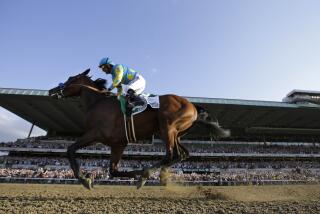These Days, Girls Are on a Roll at Soap Box Derby
- Share via
AKRON, Ohio — Mikayla Wobrak seems an unlikely symbol of the cultural changes that saved the All-American Soap Box Derby from ruin.
She doesn’t know who Indy Racing League driver Danica Patrick is, and, smiling, she describes how she was inspired to begin Soap Box racing not by drag-racing pioneer Shirley Muldowney, but by two boys who live next door to her in North Huntingdon, Pa.
But, after being told that girls were banned from the derby until 1972, Mikayla, 11, suddenly sounds like a suffragist.
“I think that they should’ve let girls compete” before 1972, she declared, “because, like, girls can race as good as boys.”
She’s proof of that.
Mikayla beat a bunch of boys to win the stock division at her local Soap Box championship. As a result, she and her family spent a week in Akron, Ohio, with more than 500 local champions -- nearly half of them girls -- from 40 states and five countries. All were preparing for last Saturday’s 69th All-American Soap Box Derby championships.
That Mikayla was there is proof of her determination: She finished seventh in her local championship two years ago, fourth last year, and finally won it this year.
And that the national championships took place at all -- with ESPN broadcasting the medal rounds live for the first time -- is proof of three decades of adaptation by an organization that still, at times, battles the perception that time has passed it by.
“People sometimes ask me if there’s still a Soap Box Derby,” said Jeff Iula, the derby’s general manager and historian. “I tell them, ‘Absolutely.’ ”
If the mention of the Soap Box Derby conjures images of flat-topped boys cruising down hills in hand-made wooden racers, that would accurately depict the heyday of the sport in the 1950s and 1960s.
Started in 1933, by the 1960s the derby boasted more than 20,000 contestants competing across the country in 250 local championships. Akron would come to a halt as 30,000 people flooded into the city to watch race day alongside Hollywood celebrities brought in by the corporate sponsor, Chevrolet.
But when Chevrolet pulled its sponsorship and its $1 million in support in 1972, participation plummeted immediately. More than 100 local clubs closed their racing hills the next year.
The sport had as few as 83 clubs in the mid-1980s.
“It was pretty bleak,” said Tony DeLuca, the derby’s executive director since 1989.
The first change the derby made to try to win back supporters was to include girls. The lifting of the ban didn’t have an immediate effect, but later changes would encourage more girls to participate, including the creation of a “rally” series and two new classes of cars, which both allowed more kids ages 8 to 17 to compete.
Perhaps most importantly, in 1992, it started selling easy-to-build kit cars, rather than requiring families to build them from scratch. It reduced the time of making a car from months to an afternoon.
The result has been steady growth. With five to 10 new clubs a year, there are now 160 local clubs nationwide -- something corporate America has noticed.
Levi Strauss is the named sponsor of this year’s race. Other major national backers include NASCAR, Toyota, Dodge, Goodyear and Pokemon trading cards.
For many parents, the derby stands as a pure slice of Americana, which may help explain corporate America’s interest, said Raymond Schuck, a popular-culture expert at Bowling Green State University in Ohio.
“Sports are seen as a transmission of values from one generation to another -- teamwork, sportsmanship,” Schuck said. “Soap Box is part of that.”
The derby has managed to balance changes while holding onto many of its time-honored traditions.
“They really treat the kids like champions,” said Jeff Wobrak, 43, Mikayla’s father.
Pageantry aside, race day loomed brightest to Mikayla. She thought her chances were as good as anyone else’s.
“I know I have to get lower in the car, get my shoulders back so there’s no room for air to go through,” she said after her trial run. “I want to go faster.”
Mikayla placed eighth, but in a way, she triumphed: Two of the six individual division winners were girls.
More to Read
Sign up for Essential California
The most important California stories and recommendations in your inbox every morning.
You may occasionally receive promotional content from the Los Angeles Times.













